Microfluidic detection device and method for detecting molecules using the same
a microfluidic detection and detection device technology, applied in the direction of biological material analysis, instruments, material analysis, etc., can solve the problems of virus detection and epidemic prevention becoming major issues for global health, high cost of developed devices, and large system bulk, etc., to achieve high permeability, suitable for biomolecule analysis, and considerable safety
- Summary
- Abstract
- Description
- Claims
- Application Information
AI Technical Summary
Benefits of technology
Problems solved by technology
Method used
Image
Examples
example 1
FIG. 1a shows a perspective view of a microfluidic detection device of the present invention. The detection device includes a wicking pad 10, a porous membrane 11, and an optical sensor 12. In the detection device; the porous membrane 11 has multiple pores, and these pores can constitute microfluidic channels for movement of the sample molecules. Hence, the porous membrane 11 can be an analytical membrane. In addition, the porous membrane 11 has first end 111 and an opposite second end 112. The first end 111 has a sample-loading area L for receiving sample molecules. In the present invention, a nitrocellulose membrane is used as the porous membrane 11. Nitrocellulose generally has good chemical stability and thus it is suitable to serve as microfluidic channels for biomolecules such as protein and nucleic acid.
The wicking pad 10 overlaps the second end 112 of the porous membrane 11. The sample molecules in the sample-loading area L at the first end 111 of the porous membrane 11 are ...
example 2
FIG. 1b is a perspective view of another microfluidic detection device of the present invention. The detection device of the present example includes a wicking pad 10, a porous membrane 11, an optical sensor 12, a bottom plate 13, and a sample pad 14.
The porous membrane 11 has first end 111 and an opposite second end 112. The first end 111 has a sample-loading area L for receiving sample molecules. In the present invention, a nitrocellulose membrane is used as the porous membrane 11. The second end 112 is connected with the wicking pad 10.
The bottom plate 30 has an opening 130, a first surface 131, and an opposite second surface 132. The wicking pad 10 and the porous membrane 11 are arranged on the first surface 131 of the bottom plate 13, and the sample-loading area L of the porous membrane 11 is arranged correspondingly to the opening 130 of the bottom plate 13.
The optical sensor 12 has a detection zone S that faces the porous membrane 11 in order to detect the sample molecules mo...
PUM
| Property | Measurement | Unit |
|---|---|---|
| area | aaaaa | aaaaa |
| physical environment | aaaaa | aaaaa |
| surface plasmon resonance | aaaaa | aaaaa |
Abstract
Description
Claims
Application Information
 Login to View More
Login to View More - Generate Ideas
- Intellectual Property
- Life Sciences
- Materials
- Tech Scout
- Unparalleled Data Quality
- Higher Quality Content
- 60% Fewer Hallucinations
Browse by: Latest US Patents, China's latest patents, Technical Efficacy Thesaurus, Application Domain, Technology Topic, Popular Technical Reports.
© 2025 PatSnap. All rights reserved.Legal|Privacy policy|Modern Slavery Act Transparency Statement|Sitemap|About US| Contact US: help@patsnap.com



